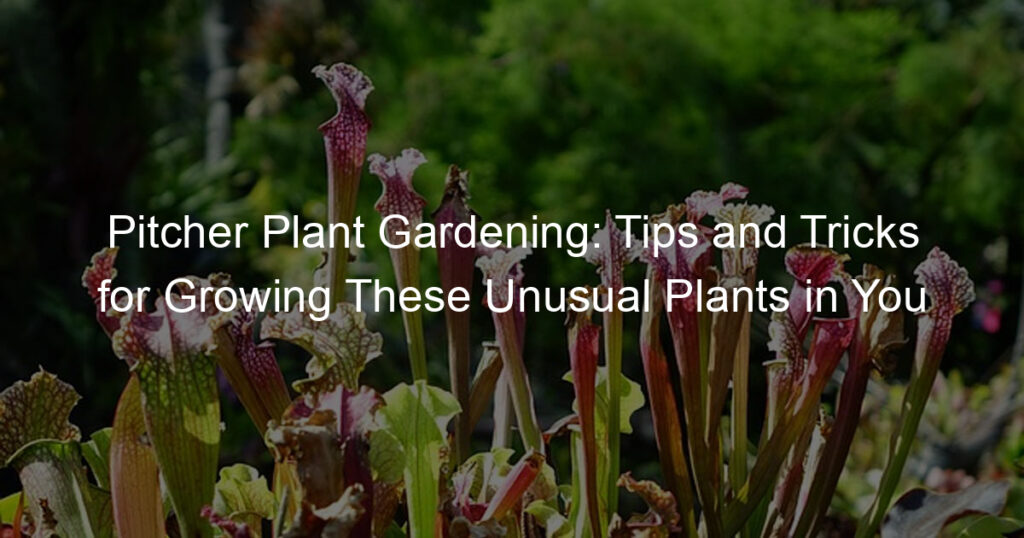Are you fascinated by the unusual beauty of pitcher plants? Do you love looking at their unique shapes and colors, but never thought that you could grow them yourself? Well, we are here to tell you that you totally can! Growing pitcher plants in your garden can be a fun and rewarding experience.
How do you care for pitcher plants?
Caring for a pitcher plant isn’t hard, but does require some attention and research. They are native to warm climates and need plenty of humidity, so the main concern is maintaining their environment.
Depending on the species, full or partial sun is needed along with plenty of draining soil that is generally airy and acidic. Watering should be done from below, as overhead water can cause rot — the pitchers can overflow with rain or mist too much, so keep an eye out!
To effectively maintain the right environment for your pitcher plant, you’ll want to fertilize every two months during the growing season and keep temperatures above 65 degrees Fahrenheit in the winter. If you have committed to taking on a pitcher plant as a pet, educate yourself about its cycle of dormancy in winter — it’s important for successful growth year-round!
What soil is best for pitcher plants?
When it comes to pitcher plants, the soil is a major player. These versatile carnivorous plants require some very specific soil conditions to thrive, so picking the right kind of dirt is essential. Opt for a light and porous medium with plenty of organic matter that can help retain moisture while draining well.
Perlite or peat moss are great components to mix into your soil and avoid anything too dense or heavy; sand or gravel can also be mixed in for extra drainage. Be sure you provide enough acidity as well since pitcher plants prefer a more acidic environment with pH levels around 6.0-6.5. With the right soil mix, you should have healthy and happy pitcher plants!
What watering schedule do pitcher plants need?
Pitcher plants are amazing oddities in the plant kingdom that love to feast on unsuspecting bugs but require a particular watering schedule for optimal growth. So when it comes to taking care of your pitcher plants, it’s important that you give them water regularly but don’t overdo it!
Generally, these plants prefer having their soil kept consistently moist, and then a good long drink once a week should do the trick. Watering too often can damage the plant, whereas when in doubt, trust that nature knows best and skip any extra fuss with watering habits. There’s no need to water daily if you’re providing regular moisture with your weekly deep watering.
How do you propagate pitcher plants?
Propagating pitcher plants is a joy for any green thumb! Generally, it’s as easy as cutting off a section of the plant itself and allowing it to root. It helps if the soil is lightly moistened before planting the cuttings, and using a rooting hormone will speed things up even more.
When transplanting the rooted cuttings, make sure that you have an appropriate-sized pot and proper soil mix using identical materials from the original plant. After watering your new plant properly, all you need to do is provide sufficient light for optimal growth and wait for your very own pitcher plant to flower!
What pests and diseases affect pitcher plants?
Pitcher plants are a fascinating species of carnivorous plants that thrive in wet, acidic environments and attract a wide variety of insects to serve as their meals. Unfortunately, these tricky little plants are susceptible to pests and diseases just like any others.
Common issues include powdery mildew, fungal infections, root rot, infestations from aphids, and even some viruses. These ailments can be deadly for pitcher plants if left unchecked. Therefore, it is important for those who own them to constantly assess their health by inspecting the leaves for signs of damage or discoloration.
Treatments vary depending on the pest or disease but often involve spraying with fungicides or introducing beneficial bugs like ladybugs that prey upon the invaders. Ultimately, proper care and attention will keep pests and diseases at bay and ensure your pitcher plant stays healthy!
How do you create a pitcher plant habitat?
Creating a pitcher plant habitat is relatively simple and satisfying. Start by selecting an area with part to full sun and adequate drainage in the soil. It’s important to use a potting mix that consists mostly of peat moss, sand, and perlite for optimal growth.
If you plan on planting more than one pitcher plant it’s best to give them anywhere from 10-20 cm of space between each other. Water your newly planted pitcher plants regularly and add a slow-release fertilizer every two weeks during spring and summer for added nutrition. Once established, pitcher plants are quite resilient and thrive in many environments–just make sure they never completely dry out!
Conclusion
Gardening can be a great way to connect with nature and express your creativity. Pitcher plants are an especially rewarding challenge since they require the right balance of unique needs. Developing the perfect environment for these unusual plants is both a satisfying process and pays dividends with their hardiness and remarkable beauty when in bloom.








